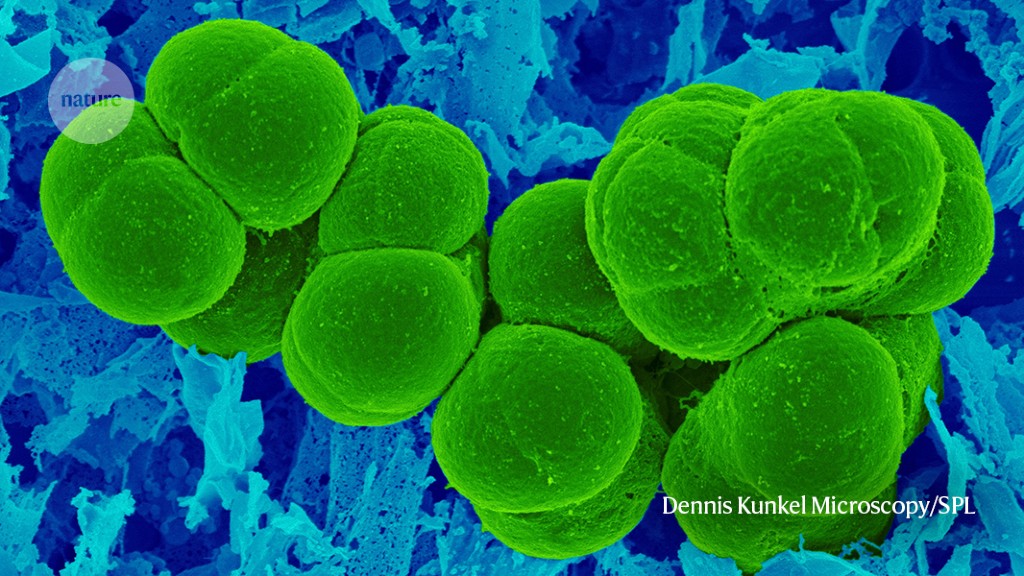Microbiologists at COP28 push for a seat at the climate-policy table

At this week’s big climate summit and beyond, scientists are campaigning for microbes to be included in climate models and solutions

The archaeon Methanosarcina barkeri produces methane in the guts of cattle.Credit: Dennis Kunkel Microscopy/Science Photo Library
Gaunt polar bears. Bleached coral reefs. Shrinking ice floes. Climate scientists and others often use emotionally impactful images such as these to illustrate the effects of global warming.
Microbiologists have more difficulty getting people to care about climate effects on the diminutive organisms they study, however. “No one thinks about microbes, because you can’t see them,” says Shady Amin, who studies marine microbiomes at New York University Abu Dhabi. Amin is one of a number of microbiologists trying to bring more attention to the part these tiny but mighty organisms play in climate change. He will make his case at the 28th annual United Nations Climate Change Conference (COP28) in Dubai, starting this week.
Microorganisms are the base of all the world’s food chains, and their responses to climate change will have wide-ranging implications for biodiversity, fisheries and agriculture. They also both produce and take up methane, carbon dioxide and nitrous oxide on tremendous scales — so that when it comes to controlling global emissions, they can be either friend or foe.
Despite these important contributions, microbes are not represented in climate models, and microbiologists don’t have a seat at the table for climate science and policy events such as COP28. Physicists, chemists and atmospheric scientists have driven these discussions, advising policymakers and researching and writing agenda-setting climate reports such as those published by the Intergovernmental Panel on Climate Change (IPCC).
That’s partly for historical reasons, says Lisa Stein, an environmental microbiologist at the University of Alberta in Edmonton, Canada. It’s mostly been these other scientists who have studied and modelled climate change. Microbiologists weren’t present when the IPCC reports were being written and, she says, “we haven’t volunteered”.
Microbiologists step up
That’s now changing. Members of the American Society for Microbiology (ASM), the International Society for Microbial Ecology (ISME) and other organizations in the field are spreading the word to policymakers in their home countries, and the societies are planning to send coordinated delegations to next year’s big climate summit — COP29, whose location has not yet been announced. Meanwhile, a few microbiologists are laying the groundwork for those interactions at this year’s meeting.
Marine scientist Raquel Peixoto is attending COP28, representing the International Coral Reef Society (ICRS) and the ISME, of which she is vice-president. She says that human influences, from climate change to pollution, are “changing the microbiome of different ecosystems and organisms in a way that’s pathogenic for us and for the planet”. She wants other scientists and policymakers to know that microbes can also help. For instance, at the King Abdullah University of Science and Technology in Thuwal, Saudi Arabia, she studies probiotics — cocktails of microbes that can counteract harmful chemicals — that could be added to coral reefs to reduce bleaching, a common side effect of rising temperatures. Interventions such as these could be “medicine to buy time”, she says.
Peixoto is the head of the ICRS’s delegation, which will take over a dedicated ‘pavilion’ or event space, at COP28 to host events and talks, including a session focused on ways to save coral reefs.
Although she is not attending the summit, Stein is pushing for scientists to pay more attention to microbes’ roles in producing and consuming methane, a short-lived and powerful greenhouse gas that is responsible for about one-third of global warming. Microbes are not involved in methane emissions related to the use of fossil fuels, but they do have a part in other human-related emissions. Organisms called archaea living in the guts of cows produce methane when helping the animals to digest their food, and microbes living in rice paddies, manure piles and landfill sites also generate the gas. Stein is part of a committee convened by the US National Academies of Sciences, Engineering, and Medicine that will next year make recommendations about which research to fund to find methane-removal solutions.
Jay Lennon, a biologist at Indiana University Bloomington and a leader of the ASM’s climate efforts, says microbes can help us to control methane emissions. On 15 November, the society published a report that suggests many possible scientific solutions. Microbiologists could develop methane-eating microbes to add to manure, or they could engineer the microbiome of the cow’s gut so that it produces less gas, for instance.
In addition to putting out reports, Lennon says, the society is stepping up its lobbying efforts, visiting members of the US Congress to discuss the economic value of the ecosystem services provided by microbes. For instance, if soil microbes are compromised by climate change, humanity will need expensive interventions to maintain the fertility of croplands, he says.
Microbes at the core
Amin’s main goal at COP28 is to spread awareness of the core role of marine microbes in maintaining the ocean’s carbon cycle and biodiversity. He’ll be speaking on two panels, where he’ll explain that climate-induced changes to the ocean mean that its uppermost layer is getting shallower — shrinking the habitat of small photosynthetic organisms called phytoplankton. These creatures take up about 10 billion tonnes of carbon every year. And the organisms that eat them eventually die and sink to the bottom of the sea, taking a substantial portion of this carbon with them. But if phytoplankton populations dwindle, the carbon cycle and the ocean’s food chains could be damaged. “We’re in for big trouble,” Amin says.
Microbiologists’ main message, Lennon says, is that humanity needs to work with these invisible, powerful organisms — and that other scientists studying climate need to work with people like him. “When people are talking about mitigation of climate change, they should include a microbiologist,” he says.
doi: https://doi.org/10.1038/d41586-023-03765-1
This story originally appeared on: Nature - Author:Katherine Bourzac


















